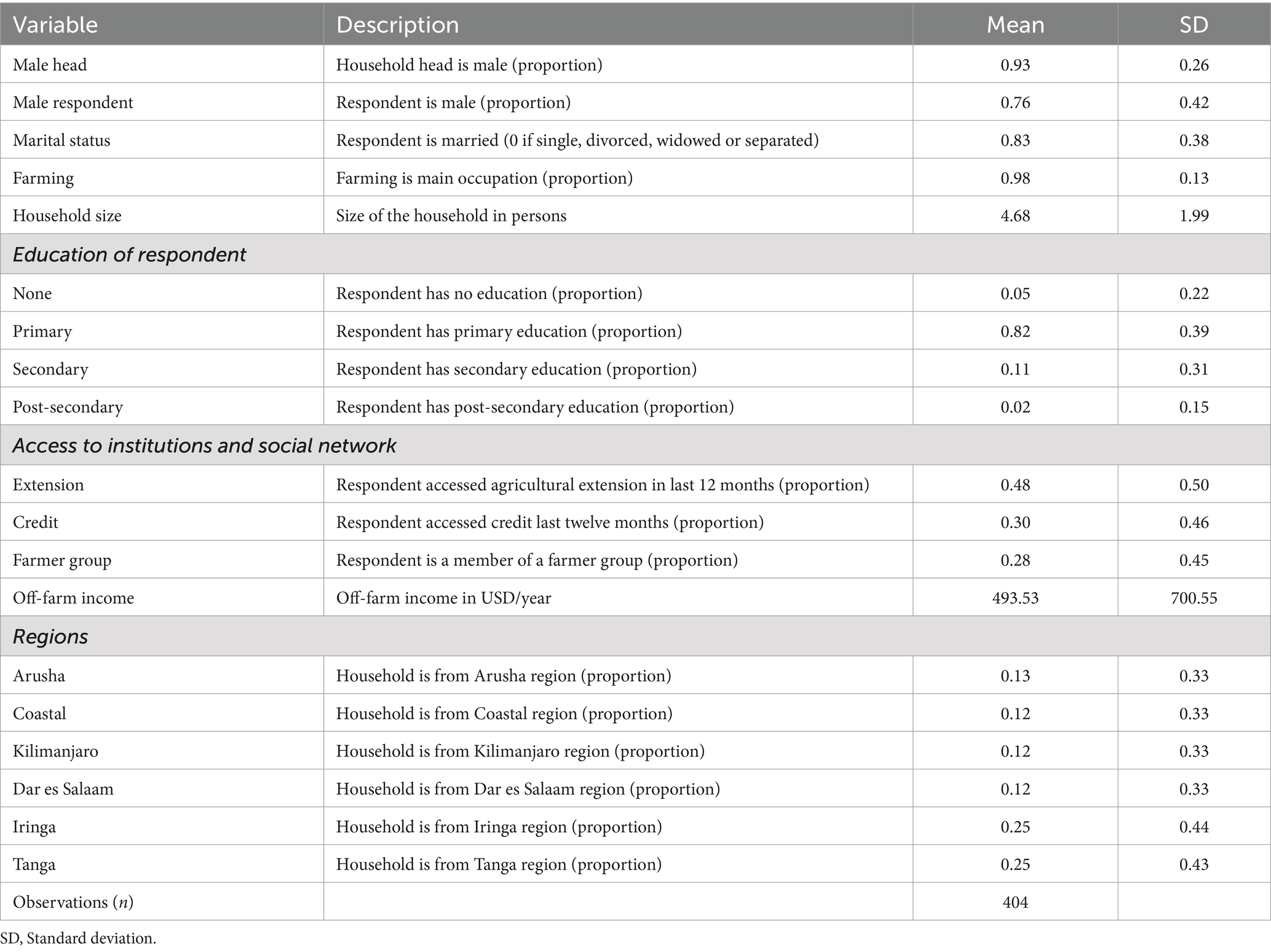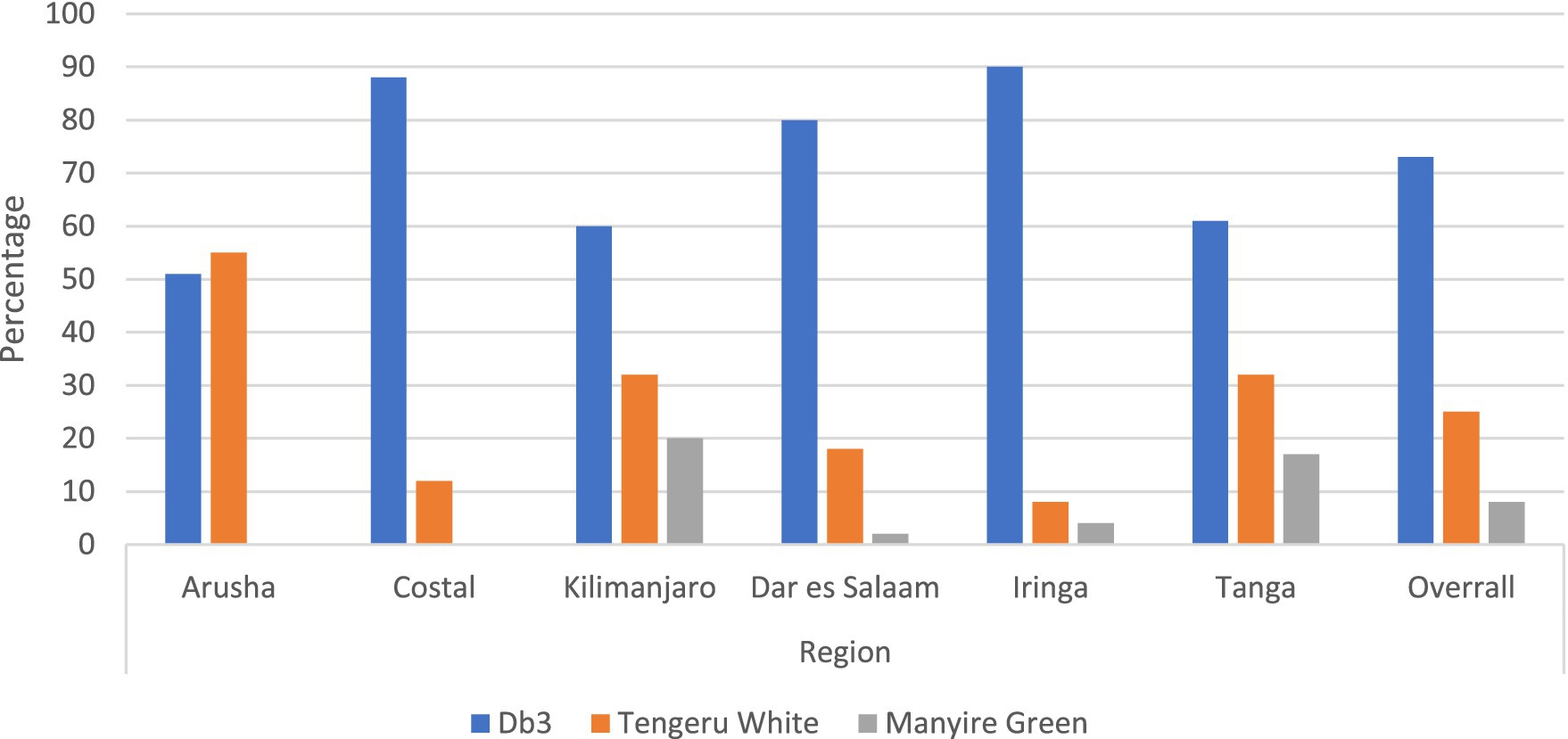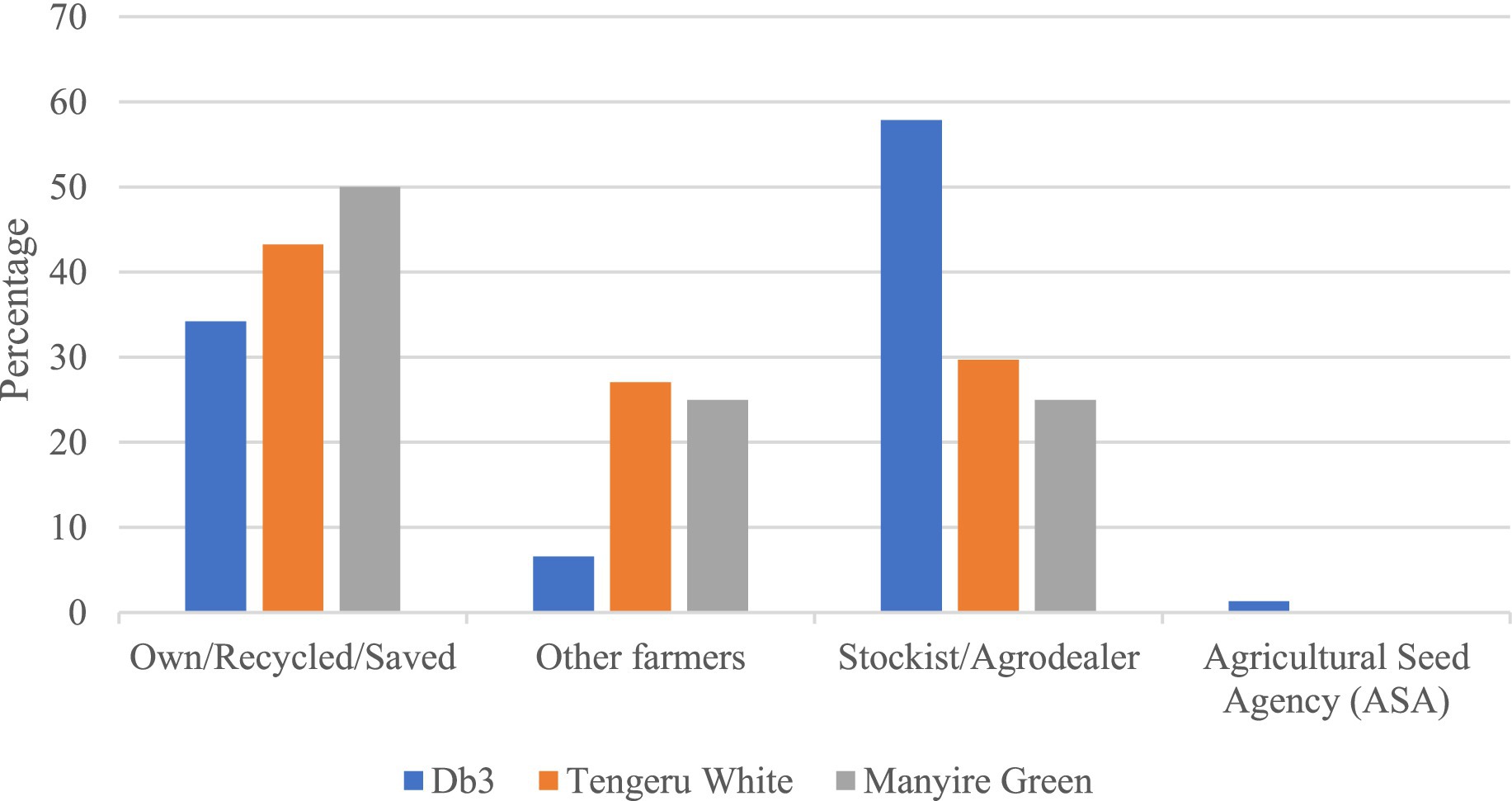- 1World Vegetable Center, Arusha, Tanzania
- 2Tanzania Agricultural Research Institute-Mikocheni, Dar es Salaam, Tanzania
- 3NIAB, Cambridge, United Kingdom
- 4World Vegetable Center, Kasetsart University, Bangkok, Thailand
African eggplant (Solanum aethiopicum) is one of the most popular traditional African vegetables in Tanzania and other countries in sub-Saharan Africa, but there is very limited information about production practices and constraints in the literature. The objective of this study was to quantify the adoption of improved African eggplant varieties and related agricultural practices, and to describe challenges associated with the production of this crop in Tanzania. To do this, we conducted interviews on a random sample of 404 farm households producing African eggplant in Tanzania. Three commonly grown African eggplant varieties identified in this study were “DB3” (adopted by 73% of households), “Tengeru White” (25%), and “Manyire Green” (8%), all of which were developed by the World Vegetable Center in Tanzania. Farmers had a preference for varieties with high yield, good market demand and good taste. Farmers earned a profit of USD 6.13 for each dollar invested in the production of African eggplant. Production of the crop is mainly constrained by pests and diseases, and low market price. Development and promotion of varieties tolerant to pests and diseases, coupled with good agronomic practices are likely to improve productivity. Promoting consumer demand for the crop could also create a more reliable market for farmers, thus increasing their income and diversifying the diets of consumers.
1 Introduction
Micronutrient malnutrition, also called hidden hunger, is an important public health concern in Africa as well as globally. It is estimated that 39% of women (15–49 years) and 62% of children (6–59 months) in the whole of Africa are anemic (WHO, 2015). At the same time, 23% is affected by hunger (FAO, ECA, and AUC, 2020) and 42% of Africa’s adult population is overweight or obese (WHO, 2019). These three forms of malnutrition have their origin in suboptimal diets that do not provide the nutrients needed for good health. While energy-rich crops have received a lot of attention in the literature, the role of micronutrient-rich crops remains undervalued. This is worrisome, particularly because it has been reported that the micronutrient density in Africa’s food supply has declined since 1980 (Beal et al., 2017).
Vegetables are an essential and irreplaceable source of vitamins, minerals, phytonutrients and dietary fiber. African region accounts low consumption of vegetables in the world and yet is rich in biodiversity of traditional vegetables (Afshin et al. 2019; van Zonneveld et al. 2021). African eggplant (Solanum aethiopicum) is one such traditional African vegetable that has received little attention in the literature. African eggplant thrives well in the warm, dry environments of West and East Africa. The optimum temperature range is 23–35°C maximum and 18–25°C minimum, and it grows on a wide range of well-drained soils with an optimal soil pH range between 5.5 and 6.8 (Mibei et al., 2017). This phenotypically diverse species is grown for its fruit and leaves. African eggplant fruits vary in color (green, white, striped, multi-colored), shape (round to long, smooth, grooved or ribbed), and size (small to large). The taste ranges from bitter to less bitter or sweet, depending on saponin content, and fruit may be consumed cooked or raw. African eggplant is ready for market when fruits turn green or white in color depending on the variety. At full physiological maturity, the fruit turns red to orange due to its carotene content (Yang and Ojiewo, 2013; Mbondo et al., 2018).
In Tanzania, African eggplant plays an important role in both the local cuisine and income generation among rural and urban resource-poor communities (Msogoya et al., 2014). According to Chadha and Mndiga (2007), African eggplant cultivation as fruit vegetable expanded in Tanzania because of its economic and nutritional value. Efforts have been made to improve the productivity of African eggplant in the country through breeding research at the World Vegetable Center (WorldVeg), which started breeding research on the crop in the mid-1990s. In doing this, WorldVeg has worked closely with the publicly-funded Tanzania Agricultural Research Institute (TARI). WorldVeg collected and characterized germplasm from across Africa, developed breeding lines, distributed improved lines to public and private research partners for evaluation, and conducted on-station and on-farm multilocation trials for the release of improved varieties by partners. Improved varieties had better resistance to pests and diseases, and had a long fruit production season, but the most important quality was reduced bitterness of the fruit, as other varieties had been very bitter tasting (Keding et al., 2007; Dinssa et al., 2016). A previous study, which collected data from seed companies in Tanzania, showed that all commercially produced seed was of two WorldVeg-developed varieties: DB-3 and Tengeru White (Schreinemachers et al., 2017); however, this was not collaborated with farm-level data. More recently, Rijk Zwaan seed company released several hybrids of African eggplant in Tanzania, including Kazinga RZ, Kerio RZ and Limpopo RZ, which are characterized by higher yields, uniformity, earliness, resistances to pests and diseases and other desirable traits such as firmness, shelf life and taste needed further down in the market chain.
Despite its importance and the effort made by both public and private sector, African eggplant has long been neglected in socioeconomic research and national statistics compared to the common eggplant/aubergine (S. melongena) and other vegetables such as tomato and onion. Until very recently, it has also been neglected by formal crop improvement programs except in eggplant breeding programs where it has been used as a source of specific traits to improve in diseases resistance in S. melongena (Mwinuka et al., 2021). This paper contributes to filling this gap by identifying farmers’ practice, varieties adopted, gains and challenges associated with African eggplant production to support local farming systems.
2 Materials and methods
2.1 Data collection and sampling procedure
Purposively sampling technique was used to select region and district with the largest area and production of African eggplant basing on Tanzania Agriculture Census (URT, 2012) and consultation from local leaders and extension officers. Stratified random sampling was also employed in the selection of the villages whereby villages where identified and listed with the help of local leaders and extension officers and grouped into strata basing on their production status. Four villages were randomly selected from the villages listed per district, at least 16 African eggplant famers from each of the selected village were randomly selected to participate in the survey. A total of 404 households were interviewed using a structured questionnaire. The respondent was the person in the household responsible for African eggplant production. The questionnaire captured household socioeconomic characteristics, variety adoption of African eggplant varieties, farmers’ varietal preference, and production constraints. Data were collected by a team of well-trained enumerators.
The desired sample size (n) was estimated following Bhalerao and Kadam (2010) as:
Where P is the proportion of the population of interest, that is smallholder vegetable farmers cultivating African eggplant, which was set to 0.5. The parameter d is the significance level and set at 5% as this is enough to remove 95% bias in sampling. The parameter Z is 1.96 and Q is a weighting variable and is computed as 1-P. Hence [(1.96)2 × 0.5 × 0.5/(0.05)2] = 384, which was approximated to 400. According to Gill and Johnson (2010) and Ahmed (2024) the sample size of at least 384 is sufficient sample for a population size above 1 million.
2.2 Data analysis
Data were analysed using descriptive statistics. Mean values and percentages were computed to show the household characteristics, levels of adoption of varieties, production practices, challenges and variation of these indicators across the sampled regions. Analysis was done using STATA software and Microsoft Excel.
Gross margin analysis (GMA) was used to estimate the profit margin gained by African eggplant farmers (Equations 1-3). GMA is the difference between total revenue and total variable costs (Equation 1). It is used as a measure of enterprise profitability and means of selecting farm plans (SAGITG, 2012). According to Fani et al. (2015), the GMA has been in use since 1960s and has been used in a number of economic studies for analyzing the profitability of farm production practices.
GM was calculated using the following formula:
Whereby:
GMi = Gross margin at point i (in USD/hectares)
TRi = Total revenue at point i (in USD)
TVCi = Total Variable costs at point i (in USD)
i = Represent points along the supply chain
Operational formula (Equation 4):
TR in this case was the amount of African eggplant sold in tonnes (Y) times their corresponding selling price (P), which is the market price. (Equation 2). TVC was the input used (X) times their corresponding buying price (Px) (Equation 3).
Where:
TR = Total Revenue for farmer
Y = Quantity of African eggplant in tonnes
Py = Selling price in USD (Market price)
PX = Price of inputs used in production of African eggplant
X = Inputs used in production of African eggplant
The final:
3 Results
3.1 Sample characteristics
Table 1 shows the social and demographic characteristics of the sampled households. Overall, 76% of the respondents were male farmers. Each household had about five members on average. More than 80% of the respondents had completed primary education, with only 5% not having attended school. Farming was the major source of livelihood with 98% reporting this as their main occupation.
3.2 Adoption and cultivation of African eggplant
Three varieties, “DB3,” “Tengeru White,” and “Manyire Green,” were identified by respondents who were asked to identify the varieties of African eggplant they cultivated during the previous production year. All three varieties originated from WorldVeg. “DB3” is the most popular variety cultivated by 73% of the sampled households, which could be attributed to its oblong fruit shape preferred in Tanzania. Twenty five percent of the households cultivated “Tengeru White,” while a small proportion (8%) cultivated “Manyire Green.” Adoption of these varieties varied across regions, for instance, “DB3” was reported in more than 50% of households in all regions, with Iringa (90%), Coastal (88%), and Dar es Salaam (80%) having the highest share of farmers growing this variety. “Tengeru White” was more popular in Arusha, Tanga and Kilimanjaro while “Manyire Green” was more popular in Kilimanjaro (20%). No household in Arusha or Coastal regions reported cultivating “Manyire Green” (Figure 1).
On average per farm, 0.21 ha of land was allocated to African eggplant (Table 2), though this varied across regions and varieties. Farmers in Arusha allocated more land to African eggplant (0.38 ha) while farmers in Tanga allocated only 0.14 ha. An area of 0.22 ha is planted to each of “DB3” and “Tengeru White” while 0.14 ha was planted to “Manyire Green.”
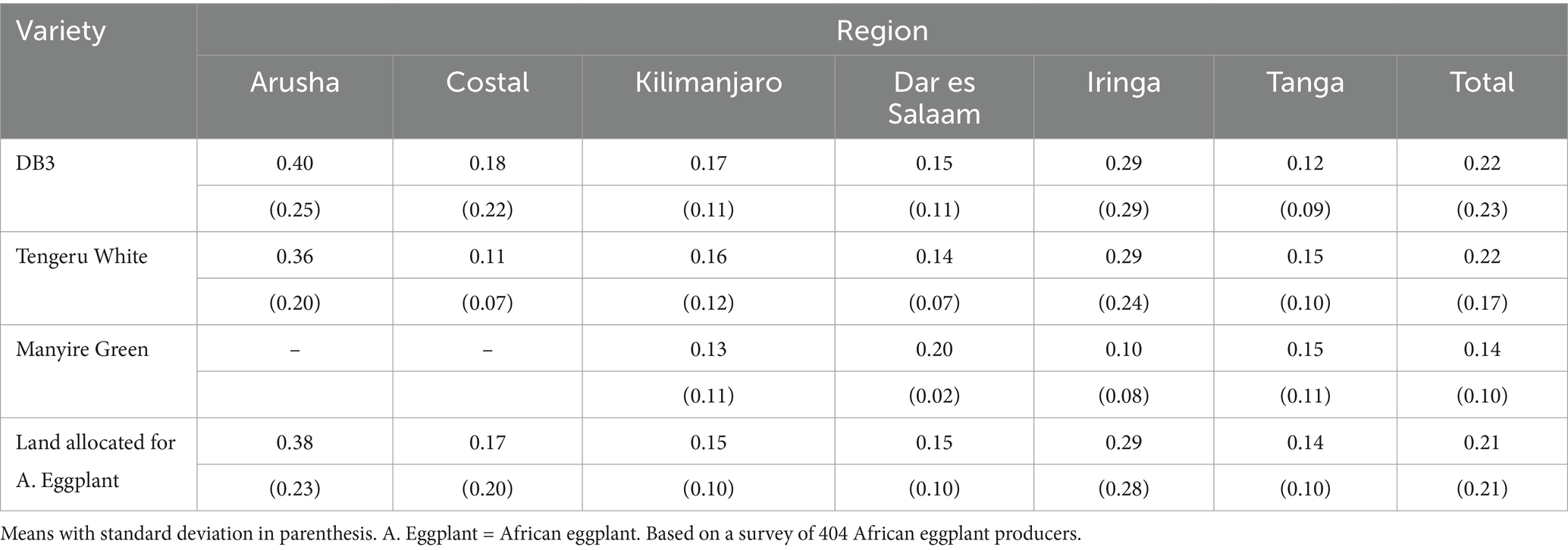
Table 2. Mean area per smallholder farm under different African eggplant varieties by region, in hectares.
The major sources of seeds were own saved seeds, seeds from agro-dealers, other farmers, and the Agricultural Seed Agency of Tanzania. “Tengeru White” (43%) and “Manyire Green” (50%) were highly recycled varieties by farmers while the seed of “DB3” (58%) was mostly obtained from agro-dealers (Figure 2).
Farmers’ preferences for variety attributes depended on the variety they grew. For instance, “DB3” was preferred because of its high yield (78%), high market demand (68%) and good taste (61%) (Table 3). High market demand was also mentioned by significant proportion of farmers who cultivated “Tengeru white” and “Manyire Green.” Other important attributes included fruit shape, and long harvest period per season, especially for “Tengeru White.”
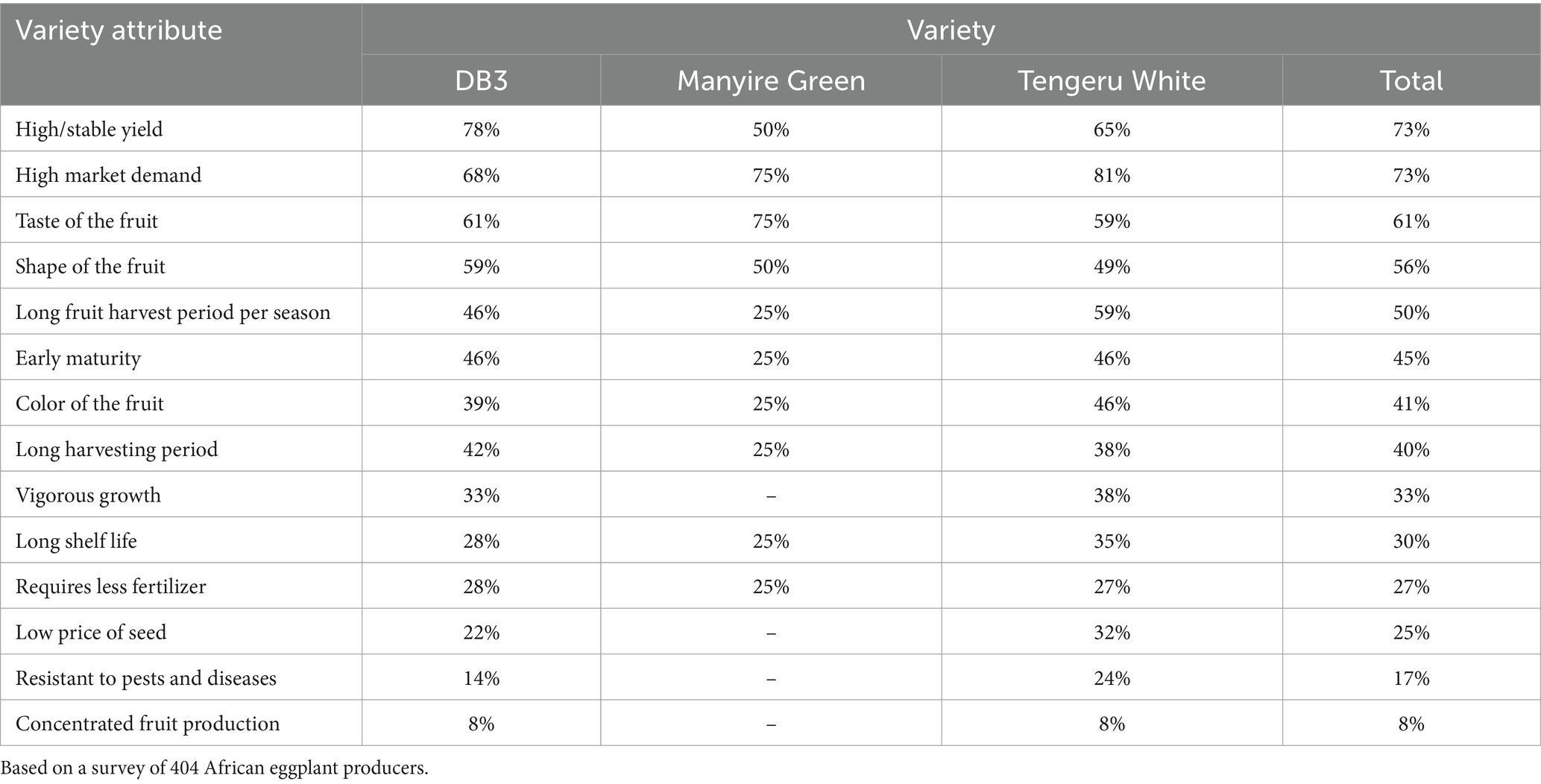
Table 3. Factors influencing preference for different African eggplant varieties, in the percentage of respondents growing a particular variety, Tanzania.
3.3 Production practices
Farmers used about 588 grams (g) of seed per hectare on average (Table 4). The seed rate varied significantly across regions. For instance, in Iringa region farmers used 1,265 g/ha while those in Dar es Salaam used 166 g/ha. The most widely adopted soil management practice was the use of mineral fertilizer (50%) and manure (40%). Other practices included crop rotation (28%), chemical pesticides (17%), mulching (16%) and crop residues (stems and leaves) after harvesting (15%). About 80% of African eggplant growers in the study area used irrigation. The most common irrigation practices included farrow irrigation (38%), watering can/bucket (36%), and water pump (25%).
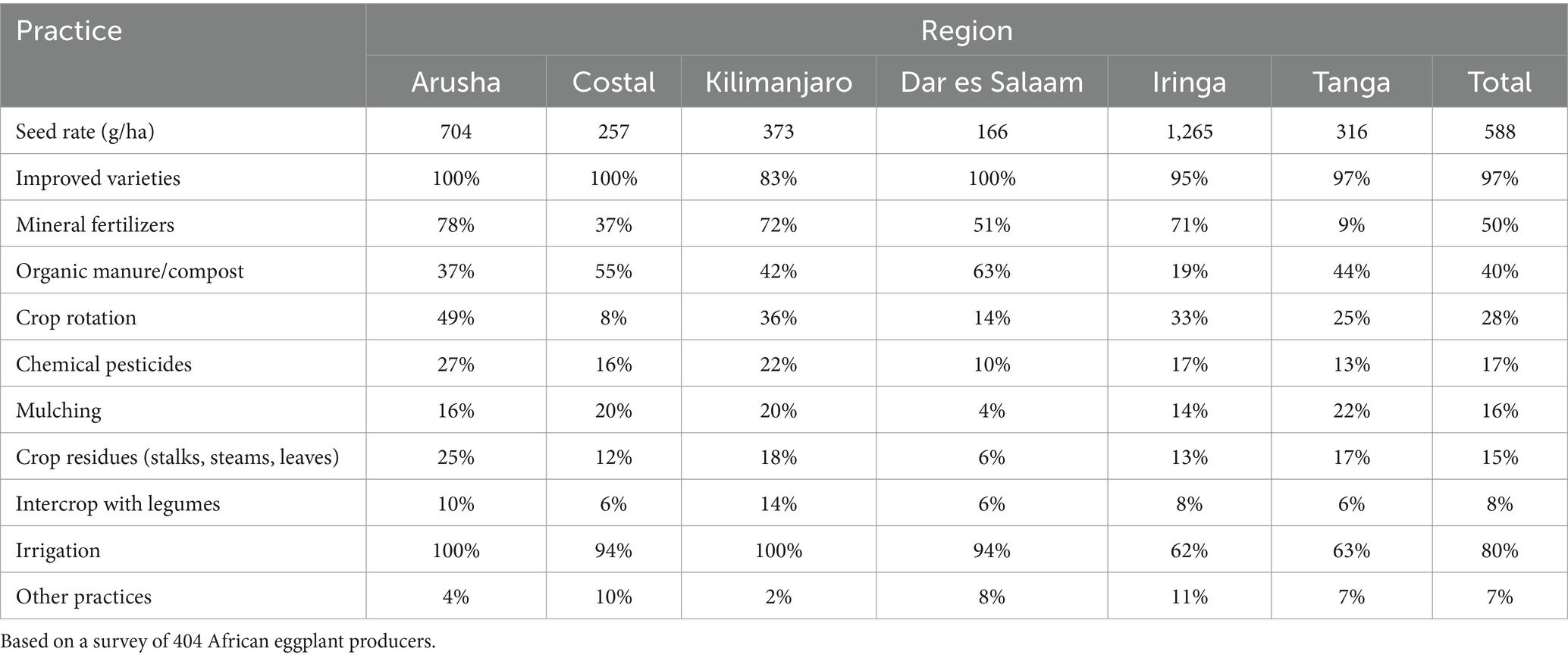
Table 4. Seed rate and soil management practices used in the cultivation of African eggplant in Tanzania, in the percentage of farmers applying the practice unless indicated otherwise.
3.4 Postharvest handling
African eggplant, like most other vegetables, is prone to losses that occur at different stages during the postharvest handling (from harvesting, through handling, packing, storage, and transportation to final delivery of the fresh produce to consumers) (Table 5). Approximately 33% of respondents store their fresh produce on the ground in the shade immediately after harvest while 27% use plastic sacks, and 23% use buckets to store their fresh produce. When questioned further in how farmers prevent spoilage after harvest, 30% reported that they only harvest when a buyer is identified while 27% said that they wait until the weather is cool for harvesting. It is generally agreed that appropriate packaging and processing of the harvested African eggplant reduces damage and increases marketability, 36% of respondents reported to be doing some level of value addition, including sorting, grading, and cleaning. Moreover, 6% of the total African eggplant harvest was estimated to be lost during postharvest handling on the farm.
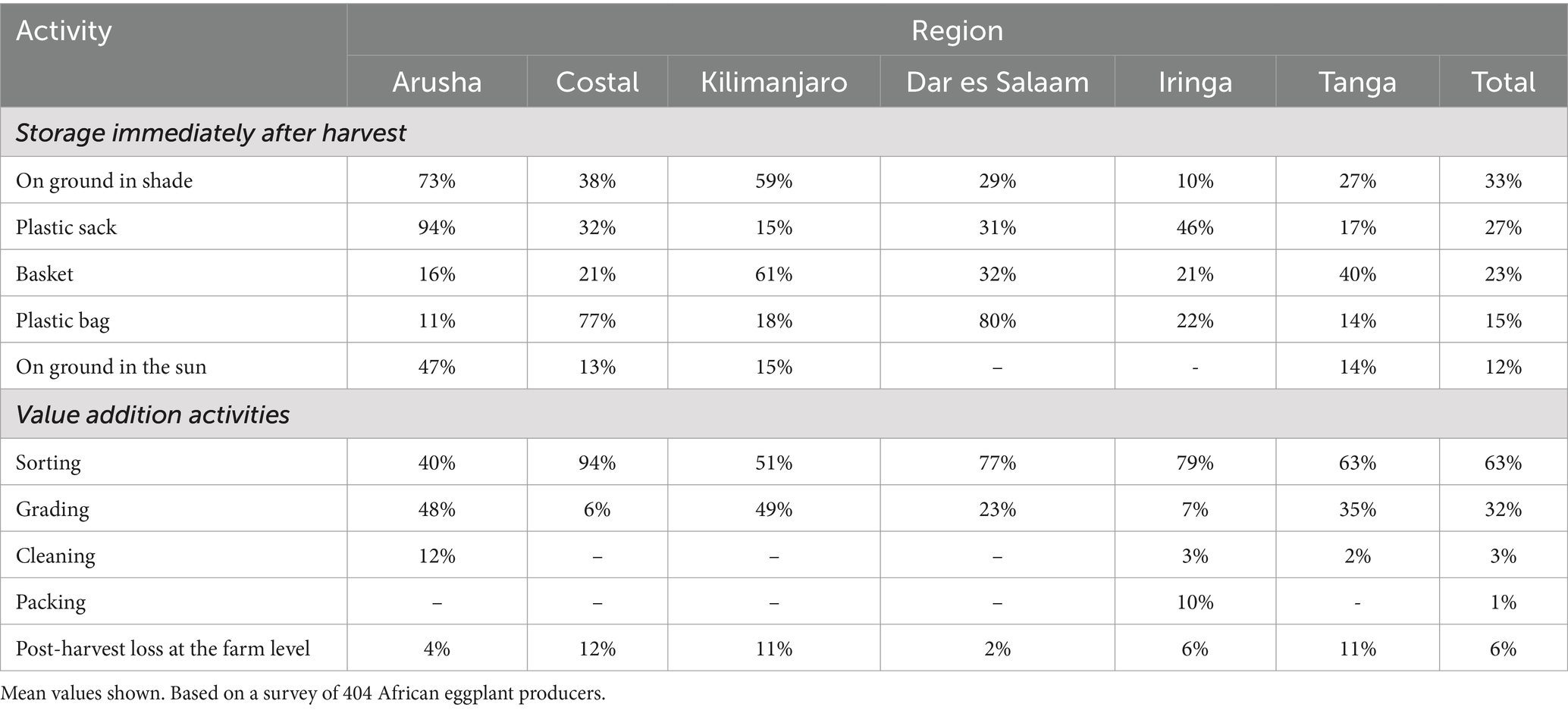
Table 5. The percentage of households applying postharvest handling and value addition activities, Tanzania.
3.5 Utilization and gains
The study employed a gross-margin analysis to calculate farmer profits from producing African eggplant. On average, African eggplant producers harvested 9.35 tons of African eggplant per hectare and 8.65 tons is sold (Table 6). The average cost of production was USD 289.92 per hectare. The cost of production, however, varied across regions with farmers in Arusha, Iringa and Kilimanjaro recording significantly higher costs (over USD 100 per hectare) while those in Tanga recording slightly <USD 50 per hectare. Farmers in Iringa region attained a higher gross margin ratio indicating their sales are higher compared to other districts. The Cost–Benefit ratio indicates that the average farmer earns a profit of USD 6.13 for each dollar invested in the production of African eggplant.

Table 6. Gross margin analysis of the African eggplant production in Tanzania, disaggregated by region.
Table 7 shows how the harvest was utilized in the sampled households. On average, 92% of the harvest was sold, 1% was given away to neighbors/friends for free, and 1% was used for own household consumption. Coastal and Tanga regions had slightly lower proportions of the crop sold as compared to other regions.
3.6 Constraints
Table 8 shows the challenges faced in the production of African eggplant. Pests and diseases were identified as the most important challenges in the production of African eggplant as reported by 84% of respondents. The most common pests and diseases included whitefly, spider mite, bacterial wilt, leaf blight and leaf spot. Low market price and lack of markets for the produce (64%) and shortage of finance for purchasing inputs (39%) were also mentioned by a large proportion of farmers.
4 Discussion
This study was conducted to quantify the adoption of African eggplant varieties, describe agricultural practices, and to identify challenges in production in Tanzania. The survey results identified three African eggplant varieties, “DB3,” “Tengeru white” and “Manyire Green,” predominantly grown in Tanzania. “DB3” was the most popular with 97% of farmers using improved seed of the variety. The three varieties originated from the WorldVeg breeding program and were developed with project support of the Federal Ministry of Economic Cooperation and Development, Germany (2003–2009) and the Bill & Melinda Gates Foundation (2007–2009). One previous study also showed that “DB3” and “Tengeru White” accounted for 98% of the commercial seed production in Eastern and Southern Africa, and 100% of seed production in Tanzania (Schreinemachers et al., 2017). Our results showed that “DB3” was selected due to its high yield, good taste and high market demand.
Cultivation of African eggplant in Tanzania is mainly done using irrigation. This is complemented with the use of improved seed varieties, application of chemical fertilizers, organic manure/compost, and crop rotation. Other practices applied in small proportions include the use of chemical pesticides, mulching, intercropping and use of crop residues. Application of these practices however varied across regions, which is important for targeting in future projects to achieve optimal impact. The findings here show that farmers earn on average USD 6.13 for every dollar they invest in the production of African eggplant, which is much higher than what was reported by Schreinemachers et al. (2017) who estimated social gains using an economic surplus model. This indicates the great potential of African eggplant in improving livelihoods through increased farmer income. Production of African eggplant in Tanzania, however, is constrained by pest and diseases, and low market prices according to farmers.
5 Conclusion
In conclusion, smallholder farm households in the study area have widely adopted improved varieties of African eggplant. There is a potential for farmers to obtain higher returns if production is complemented with good agricultural practices. Efforts to develop varieties with better pest and disease resistance remain necessary. These varieties will need to be demand driven selected in order to reduce challenges in the marketing of African eggplant. There is also a need to promote and scale out good agricultural and agroecological practices as the study identified low adoption rates for most of cultural practices. The study relies on cross-sectional data for which some indicators can change with time hence future studies could employ longitudinal data to capture seasonality and time variation.
Data availability statement
The raw data supporting the conclusions of this article will be made available by the authors, without undue reservation.
Ethics statement
Ethical review and approval was not required for the study on human participants in accordance with the local legislation and institutional requirements. Written informed consent from the (patients/participants or patients/participants legal guardian/next of kin) was not required to participate in this study in accordance with the national legislation and the institutional requirements.
Author contributions
HM: Conceptualization, Data curation, Formal analysis, Investigation, Methodology, Validation, Visualization, Writing – review & editing. RW: Investigation, Writing – review & editing. FD: Writing – review & editing, Funding acquisition, Project administration. GN: Data curation, Validation, Writing – review & editing. JS: Data curation, Visualization, Writing – review & editing. RM: Methodology, Validation, Visualization, Writing – review & editing. GB: Funding acquisition, Project administration, Writing – review & editing. PS: Conceptualization, Investigation, Supervision, Validation, Writing – review & editing.
Funding
The author(s) declare that financial support was received for the research and/or publication of this article. This work received financial support from the UKRI BBSRC GCRF SASSA initiative grant ref. BB/R020655/1, and long-term strategic donors to the World Vegetable Center: Taiwan, UK aid from the UK government, United States Agency for International Development (USAID), Australian Centre for International Agricultural Research (ACIAR), Germany, Thailand, Philippines, Korea, and Japan.
Acknowledgments
The authors are grateful to farmers who participated in the study and provided the information needed for this work.
Conflict of interest
The authors declare that the research was conducted in the absence of any commercial or financial relationships that could be construed as a potential conflict of interest.
Publisher’s note
All claims expressed in this article are solely those of the authors and do not necessarily represent those of their affiliated organizations, or those of the publisher, the editors and the reviewers. Any product that may be evaluated in this article, or claim that may be made by its manufacturer, is not guaranteed or endorsed by the publisher.
References
Afshin, A., Sur, P. J., Fay, K. A., Cornaby, L., Ferrara, G., Salama, J. S, et al. (2019). Health effects of dietary risks in 195 countries, 1990–2017: A systematic analysis for the global burden of disease study 2017. Lancet. 393, 1958–1972. doi: 10.1016/S0140-6736(19)30041-8
Ahmed, S. K. (2024). How to choose a sampling technique and determine sample size for research: a simplified guide for researchers. Oral Oncol. Rep. 12:100662. doi: 10.1016/j.oor.2024.100662
Beal, T., Massiot, E., Arsenault, J. E., Smith, M. R., and Hijmans, R. J. (2017). Global trends in dietary micronutrient supplies and estimated prevalence of inadequate intakes. PLoS One 12:e0175554. doi: 10.1371/journal.pone.0175554
Bhalerao, S., and Kadam, P. (2010). Sample size calculation. Int. J. Ayurveda Res. 1, 55–57. doi: 10.4103/0974-7788.59946
Chadha, M. L., and Mndiga, H. (2007). African eggplant - from underutilized to a commercially profitable venture. Acta Hortic. 752, 521–524. doi: 10.17660/actahortic.2007.752.96
Dinssa, F. F., Hanson, P., Dubois, T., Tenkouano, A., Stoilova, T., Hughes, J. D. A, et al. (2016). AVRDC—The World Vegetable Center’s women-oriented improvement and development strategy for traditional African vegetables in sub-Saharan Africa. Eur. J. Hortic. Sci. 81, 91–105.
Fani, R., Odoemenem, I. U., and Oben, N. E. (2015). Gross margin analysis and constraints faced by small scale Rice producers in the west region of Cameroon. J. Biol. Agric. Healthcare 5, 2224–3208.
FAO, ECA, and AUC (2020). Africa regional overview of food security and nutrition 2019: Containing the damage of economic slowdowns and downturns to food security in Africa. Accra: Food and Agriculture Organization of the United Nations, Economic Commission for Africa, African Union Commission.
Keding, G., Weinberger, K., Swai, I., and Mndiga, H. (2007). Diversity, traits and use of traditional vegetables in Tanzania. AVRDC-World Vegetable Center.
Mbondo, N. N., Owino, W. O., Ambuko, J., and Sila, D. N. (2018). Effect of drying methods on the retention of bioactive compounds in African eggplant. Food Sci. Nutr. 6, 814–823. doi: 10.1002/fsn3.623
Mibei, E. K., Ambuko, J., Giovannoni, J. J., Onyango, A. N., and Owino, W. O. (2017). Carotenoid profiling of the leaves of selected African eggplant accessions subjected to drought stress. Food Sci. Nutr. 28, 303–325. doi: 10.1002/j
Msogoya, T. J., Majubwa, R. O., and Maerere, A. P. (2014). Effects of harvesting stages on yield and nutritional quality of African eggplant (Solanum aethiopicum L.) fruits. J. Appl. Biosci. 78:6590. doi: 10.4314/jab.v78i1.1
Mwinuka, P., Boniface, P., Mbilinyi, W. B., Mbungu, S. K., Mourice, H. F., and Mahoo, P. S. (2021). Optimizing water and nitrogen application for neglected horticultural species in tropical sub-humid climate areas: a case of African eggplant (Solanum aethiopicum L.). Sci. Hortic. 276:109756. doi: 10.1016/j.scienta.2020.109756
Schreinemachers, P., Sequeros, T., and Lukumay, P. J. (2017). International research on vegetable improvement in east and southern Africa: adoption, impact, and returns. Agric. Econ. 48, 707–717. doi: 10.1111/agec.12368
URT. (2012). National sample census of agriculture 2007/2008. Volume II: crop sector - National Report. Available online at: http://www.agriculture.go.tz/publications/englishdocs/ (Accessed April 14, 2023).
van Zonneveld, M., Kindt, R., Solberg, S. Ø., N’Danikou, S., and Dawson, I. K. (2021). Diversity and conservation of traditional African vegetables: Priorities for action. Diversity and Distributions. 27, 216–232.
WHO (2019). Atlas of African health statistics 2019. Geneva: African Health Observatory, World Health Organization Regional Office for Africa Brazzaville, Congo.
Keywords: traditional African vegetables, African eggplant, improved varieties, technology adoption, gross margin analysis
Citation: Mvungi H-HA, Wanyama R, Dinssa FF, Ngoteya G, Sigalla J, Minja R, Bishop G and Schreinemachers P (2025) Production of African eggplant in Tanzania: varieties, practices, profitability, and constraints. Front. Sustain. Food Syst. 9:1461851. doi: 10.3389/fsufs.2025.1461851
Edited by:
Annamalai Muthusamy, Manipal Academy of Higher Education, IndiaReviewed by:
A. Amarender Reddy, National Institute of Agricultural Extension Management (MANAGE), IndiaManoj Kumar, Bihar Animal Sciences University, India
Copyright © 2025 Mvungi, Wanyama, Dinssa, Ngoteya, Sigalla, Minja, Bishop and Schreinemachers. This is an open-access article distributed under the terms of the Creative Commons Attribution License (CC BY). The use, distribution or reproduction in other forums is permitted, provided the original author(s) and the copyright owner(s) are credited and that the original publication in this journal is cited, in accordance with accepted academic practice. No use, distribution or reproduction is permitted which does not comply with these terms.
*Correspondence: Henry-Hussein Aziz Mvungi, aGVucnkubXZ1bmdpQHdvcmxkdmVnLm9yZw==
 Henry-Hussein Aziz Mvungi
Henry-Hussein Aziz Mvungi Rosina Wanyama1
Rosina Wanyama1 Fekadu Fufa Dinssa
Fekadu Fufa Dinssa Gerard Bishop
Gerard Bishop Pepijn Schreinemachers
Pepijn Schreinemachers